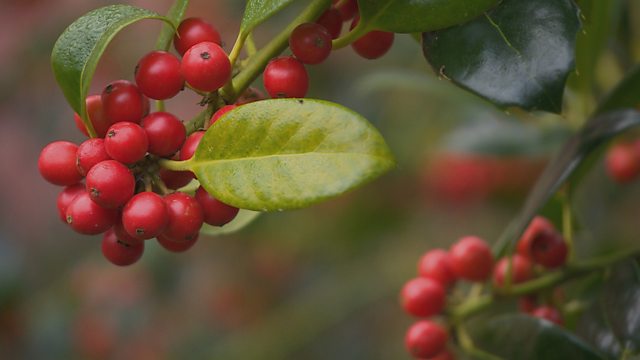
Episode 30
In the fourth of her films about botany, Carol Klein explores the inner workings of leaves - how they harness the sun's energy and turn it into food. And Joe Swift meets Griff Rhys Jones for a private tour of his remarkable garden and discovers what a passionate gardener he is.
Last on
Clips
-
![]()
DIY plant supports
Duration: 02:48
-
![]()
Griff Rhys Jones
Duration: 06:02
Ground cover plants

In this week’s show, Monty chooses plants to act as ground cover in his wildlife garden. Ground cover plants are essential for the border, yet are so often overlooked. With careful planning, they can be used to form a dense mat of foliage which is fantastic for suppressing weeds. They also provide shelter for small mammals and birds, and many have flowers that are attractive to insects. Interplant with bulbs for maximum colour and interest!
Monty’s ground cover choices:
- Euphorbia amygdaloides var. robbiae (Mrs Robb's bonnet) Evergreen perennial with dark green leaves and rounded sprays of yellow-green flowers. Good for dry shade.
- Geranium macrorrhizum 'Spessart' Hardy perennial with pinky-white flowers and aromatic leaves that take on rich autumn tints. Performs well in dry shade.
- Hedera helix (Common ivy) Valued for its ability to thrive in deep shade, ivy can quickly cover large areas. Its flowers and berries are also an important source of food for birds and insects.
- Vinca major (Greater periwinkle) Vigorous evergreen with glossy leaves and violet-blue flowers. Easy to grow in all but the driest of soils. Flowers best in full sun, but useful for shady areas too. Can be invasive.
- Vinca minor 'Atropurpurea' (Dark purple-flowered periwinkle) Another lovely periwinkle with deep reddish-purple flowers.
You could also try:
- Ajuga reptans ‘Caitlin’s Giant’ (Bugle) Low-growing perennial with short spikes of blue flowers in spring. Will tolerate any soil so long as there is some moisture. Best in partial shade to prevent scorching.
- Alchemilla mollis (Lady’s mantle) Herbaceous perennial forming a clump of softly hairy, light green leaves with sprays of acid-yellow flowers. Will thrive in sun or partial shade provided there is some moisture. Prone to self-seeding.
- Galium odoratum (Sweet woodruff) Vigorous perennial bearing whorls of bright green, lance-shaped leaves that smell of hay when dry. Has clusters of starry white flowers from late spring.
- Pachysandra terminalis (Japanese spurge) Attractive evergreen with toothed, glossy green leaves and stubby spikes of small white flowers in early summer. Will thrive on most soils, particularly where there is plenty of moisture, in full or partial shade.
- Tellima grandiflora (Fringe cups) Compact perennial with tall racemes of small, cream flowers that often fade to light red. Prefers a humus-rich, moisture-retentive soil in partial shade.
(www.rhs.org.uk)
Jobs for the weekend: Save self-seeded forget-me-nots
Forget-me-nots often self-seed in the garden, but if they’ve popped up in the wrong place, don’t waste them! Either dig them up and move them to their new position, or transfer them to a seed tray or pot until you’re ready to plant them out.
(www.rhs.org.uk)
Jobs for the weekend: Remove figs that won’t ripen
Your fig tree may be covered in green fruit, but there’s little chance of it ripening now. To help conserve energy, remove anything larger than a pea, leaving behind the tiny embryo figs in the leaf axils. With luck, these will survive the winter and supply you with a bumper crop next year.
(www.rhs.org.uk)
Jobs for the weekend: Sow broad beans
If you sow broad beans now, there’s a good chance you’ll get an extra early crop next spring. You can either sow them direct in the soil or in pots for planting out at a later date. Whichever method you use, choose a hardy variety like ‘Aquadulce’.
(www.rhs.org.uk)
Credits
| Role | Contributor |
|---|---|
| Presenter | Monty Don |
| Presenter | Carol Klein |
| Presenter | Joe Swift |
| Series Producer | Chloe Rawlings |
| Series Editor | Liz Rumbold |


